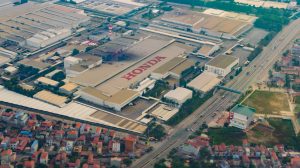When U.S. President Donald Trump unveiled his tariff plan to the world a few weeks ago, Southeast Asian countries were especially hard hit, with tariffs ranging from 18 percent on the Philippines to nearly 50 percent on Cambodia. Malaysia, Indonesia, Thailand, Vietnam, and Laos were looking at tariffs of between 24 and 48 percent.
ASEAN was seemingly treated more harshly than other regions because many of its member states run trade surpluses (in goods) with the United States, and Trump is obsessed with bilateral trade imbalances. Although the U.S. backed down within days, Trump’s wild ride does raise an interesting question: Why do so many countries in Southeast Asia run large trade surpluses, and is this actually a bad thing?
The simple answer is that countries in Southeast Asia run large trade surpluses because many have followed a model of economic development called export-oriented industrialization. One of the more reliable ways for an emerging market to accelerate economic growth is to manufacture things like textiles and electronics and then export them to foreign markets. Emerging markets can make these goods at lower cost because production inputs, such as labor, are generally lower than they are in the U.S. or Europe.
This model of economic development has been supported by and benefited the U.S. for decades, and has been championed by stewards of the liberal international order such as the World Bank. This type of development has been particularly effective in Asia, with the World Bank famously dubbing it the East Asian miracle in the 1990s.
In Southeast Asia, Thailand has used this model to transform itself into an export powerhouse. Vietnam’s phenomenal recent growth has followed the same trajectory, with big foreign companies like LG and Nike investing billions of dollars to build production facilities in the country. The explicit purpose of locating production in Vietnam and Thailand is to produce goods at a lower cost so they can be exported to foreign markets.
If you are following the logic of this strategy, you will have noticed that running a large trade surplus with the rest of the world is the entire point of this type of economic development. And with the U.S. being a massive market with an appetite for affordable goods, it’s not surprising that such a global economic system produces net exporting countries that run sizable trade surpluses with it.
Trump believes this is unfair, and also bad for the United States. Is he right to think that? Export-led industrialization often involves state intervention in markets to make exports more competitive. Net surplus countries frequently manipulate their currencies (an undervalued currency boosts exports), suppress wages, and subsidize or otherwise protect certain industries so they can gain an advantage in global markets. You might call this unfair.
And there is some truth to the claim that global trade has become unbalanced, especially given the geopolitical context of a rising China driving growth by exporting surplus production to the rest of the world, a lot of which is indeed absorbed by the United States. But what would a more sustainable balance look like? Biden’s idea was to make the U.S. a more attractive location for high-value production and investment by pursuing an American version of industrial policy. Trump’s idea has been to slap tariffs on every country in the world based on a poor understanding of global trade.
The result is that for decades the U.S. built and championed a system of global trade where emerging markets could industrialize by exporting surplus production to the rest of the world. They were in fact encouraged to do so, and many countries in Southeast Asia successfully followed that model. Now, the U.S. is dismantling this system in spectacular fashion because it no longer suits them. But I wonder whether the system was actually still working for the net exporting countries anyway.
It became obvious during the COVID-19 pandemic that relying on exports as an engine of economic growth was a major liability for emerging markets. It places them at the mercy of external forces over which they have little control. Thailand, the most export-dependent nation in Southeast Asia, has still not fully recovered from disruptions to global trade and travel that started in 2020, and things are only likely to get worse in the years ahead.
Even though it walked back the tariffs, the U.S. is making it crystal clear just how risky this style of economic development is and how vulnerable it is to external shocks. While it will no doubt continue in some form, the U.S.-led global economic order that gave rise to the East Asian miracle is undergoing a fundamental transformation. Exporting excess production to foreign markets like the U.S. is no longer a reliable model of economic development, especially in the current geopolitical environment.
What comes next is anybody’s guess. But there are other models of economic development, ones that require less dependence on the U.S. and don’t force developing countries to run perpetual trade surpluses. We might see regional trade within ASEAN become more important, or a bigger role for states or domestic markets in driving growth. Whatever comes next, the countries that can adapt the quickest to this new reality and develop alternative models of economic growth and development are going to have a significant advantage as we push forward into an opaque and uncertain future.

































